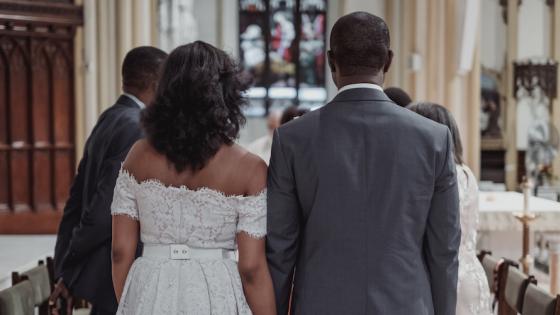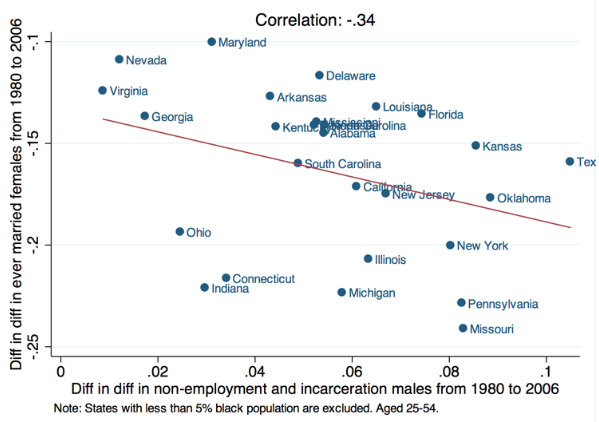The black–white differences in marriage in the US are striking. In 2006, 67% of white women between ages 25 and 54 were married, while only 34% of black women were – a gap of 33 percentage points. And as Figure 1 shows, the racial marriage gap has been increasing – it was 17 percentage points in 1980. The differences in family structure between black and white households have been an ongoing concern for policymakers. In his famous report, Moynihan (1965) saw a clear link between family structure and growing social problems, such as poverty and crime, among the black population. Today, the growing racial gap in marital status of the US population has led some researchers to question whether marriage is only for white people (Banks 2011).
Figure 1 Share of married or cohabiting black and white women across time
This dramatic racial gap in marriage matters because marital structure has important implications for the living arrangements and well-being of children. In 2015, about 54% of black children lived with a single mother, while the share of white children living with a single mother was about 22%.1 Differences in family structure are a contributing factor to differences in economic resources. In 2006, 33% of black children were living below the poverty line, while only 14% of white children were.2 A growing body of literature suggests that the conditions under which children grow up matter for their well-being as adults. Carneiro and Heckman (2003) and Cunha et al. (2006), among others, show that differences between children appear at very early ages and that the family environment plays a significant role in generating these differences.
Why do black individuals marry at lower rates than white individuals? Wilson (1987) suggests that characteristics of the black male population, and in particular the lack of marriageable black men due to high rates of unemployment and incarceration, are an important factor contributing to the black-white differences in marital status. This is usually referred to as the ‘Wilson hypothesis’.
Figure 2 illustrates this hypothesis. The horizontal axis shows by how much more the share of incarcerated or non-employed men increased for black men than for white men from 1980 to 2006 across US states, while the vertical axis shows by how much more the share of never-married women declined for black than for white women. In Pennsylvania, for instance, the share of men without a job or in prison increased by 8 percentage points more for black men than for white men. At the same time, the share of women who were never married dropped by 23 percentage points more for black women than for white women. Larger increases in incarceration for men are associated with larger declines in marriage for women.
Figure 2 Changes in non-employment and incarceration of males in relation to the decline in ever married females
Since the 1970s, there have been two major developments disproportionately affecting the riskiness of black men as spouses.
First, there has been a large withdrawal of major industries from the inner cities due to skill-biased technological change and globalisation, leaving many low-skilled men without jobs. Between 1980 and 2000, the US lost two million manufacturing jobs and the decline has accelerated significantly since 2000 (Charles et al. 2018). These losses have been most pronounced for those with low levels of education. Batistich and Bond (2018) find that Japanese import competition in the 1970s and 1980s was associated with skill-upgrading in manufacturing and generated a shift of employment from low-skilled black workers to high-educated white workers. As a consequence, black men between the ages of 25 and 54 are less likely to be employed (60% versus 85% in 2006) and more likely to be unemployed (7.3% versus 3.6% in 2006) than their white counterparts.
Why did incarceration skyrocket? The development can be traced back to a press conference in 1971, in which President Richard Nixon declared illegal drugs as public enemy number one. In 1982, President Ronald Reagan officially announced the ‘War on Drugs’, leading to the introduction of several policy packages. These reforms entailed a substantial increase in anti-drug funding and incentives for police agencies to arrest drug offenders, and sentencing reforms including harsh punishments for crack distribution and possession. As a consequence, the prison population soared. In 2010 more than one in ten black men between the ages of 25 and 54 were incarcerated. This is more than five times as high as the incarceration rate for white men of the same age. Prison has become a common feature of a black man’s life. For black men born between 1965 and 1969, the cumulative risk of imprisonment by ages 30 to 34 was 20.5% compared to only 2.9% for white men (Western 2006). More than half of black men with less than a high school education pass through prison at some point before they turn 34.
Even when focusing on the civilian, non-institutionalised population, there are more black women than men due to higher mortality rates of black men. The numbers of white men and women of marriageable ages are about even, i.e. there is one man for every woman. In contrast, there are around 15% more black women between the ages of 25 and 54 than black men. This skewed sex ratio for the black population makes it less likely black women will marry.
In a recent paper (Caucutt et al. 2018), we take a dynamic look at the Wilson hypothesis in order to understand the sources of the racial marriage gap. We develop an equilibrium model of marriage, divorce, and labour supply that takes into account the transitions between employment, unemployment, and prison. Our analysis differentiates between the lack of opportunities for black women to meet black men and their decision to enter into a marriage. Given current incarceration policies and labour market prospects, black men are riskier spouses than white men. They are more likely to be, and to become, unemployed or incarcerated than their white counterparts. As a result, marriage is a risky investment for black women.
In the model economy, single men and women, who differ by earning potentials, are matched in a marriage market segmented by race. They decide whether or not to marry taking into account their next best option. Husbands and wives also decide whether to stay married and whether the wife works in the labour market. There is a government that taxes and provides welfare benefits to poor households. Men in the model move exogenously among three labour market states (employment, non-employment, and prison).
Black and white individuals differ along three key dimensions. First, there are more black women than black men, so the sex ratio for the black population is not one. Second, black men are much more likely to go to prison than white men. Third, black men are also more likely to lose their jobs. Because there are more black women than black men and a large number of black men are in prison, single black women might not meet anyone in the marriage market. Furthermore, because black men are more likely to go to prison or lose their jobs, when meetings do take place they are less likely to be end up in marriage, and existing marriages are more likely to end in divorce.
The model economy is estimated to be consistent with key marriage and labour market statistics by gender, race, and educational attainment for the US economy in 2006. Without imposing racial differences in taste parameters, the model is able to generate a racial marriage gap of 24 percentage points for currently married females. We then study how much the different components of the Wilson hypothesis – the sex ratio, and the dynamic impacts of the prison and employment transitions – contribute to this racial marriage gap. Table 1 documents our results.
Table 1 Accounting for the black-white marriage gap (fraction married)
Notes: Column ‘Black’ shows the share of married black women (above) and men (below) by education in the benchmark economy, while the column ‘White’ shows the same for white women and men. Column ‘Sex Ratio’ shows the counterfactual marriage rates of blacks if the sex ratio were equal to one. Column ‘Emp’ shows the counterfactual marriage rates of blacks if black men had the same employment transitions as white men of equal education. Column ‘Prison’ shows the counterfactual marriage rates of blacks if black men had the same prison transitions as white men of equal education. The bottom rows show the share of the marriage gap explained through the respective counterfactual experiments and the associated 90% confidence interval. ‘<HS’ denotes education level of ‘less than high school’, ‘HS’ is high school, ‘SC’ is ‘some college’, and ‘C’ is college.
The first column of Table 1 shows the fraction of the black population that is married in the model economy, while the last column shows the fraction of the white population that is married. At every education level, a larger fraction of the white population are married. For women with less than a high school degree, for example, almost 50% of white women are married, while just 17% of black women are.
In each column between the first and the last one, we eliminate the gap for one key racial difference. First, we give an equal sex ratio to the black population (‘Sex Ratio’). Next, we give black men the employment opportunities of white men (‘Emp.’). Finally, we give black men the incarceration rates of white men (column ‘Prison’). In each of these columns the marriage rate among the black population increases and approaches the marriage rate for the white population in the model economy. The last row in the table shows how much of the racial marriage gap each factor closes. We find that the sex ratio accounts for 21.2% of the gap. The effect of employment is larger 38.4%, while the effect of prison is smaller 10.4%. Next, we consider the different factors together. If black men face the employment and prison dynamics of white men, the racial marriage gap is reduced by more than 50%. Finally, putting together all three pieces of the Wilson hypothesis (eliminating black-white differences in the sex ratio, incarceration transitions, and unemployment transitions) closes more than 80% of the racial marriage gap.
Conclusions
A racial marriage gap of 33 percentage points is wide. In our research, we study the potential drivers of this gap. Changes in US labour markets in recent decades left many low-skilled workers jobless. The number of people behind bars has increased so that the US now holds 25% of the world’s prison population, while only accounting for about 5% of the world’s population. Both the decline in low-skilled jobs and the era of mass incarceration have disproportionately affected black communities, and in particular black men. We investigate whether the current bleak labour market prospects of black men and the considerable risk of being incarcerated can explain why so many black women are not marrying. Using an equilibrium model of marriage, divorce and labour supply that takes into account transitions between employment, unemployment, and prison, we are able to disentangle and quantify the key contributors to the racial marriage gap.
References
Banks, R R (2011), Is marriage for white people? How the African American marriage decline affects everyone, Dutten: New York.
Batistich, M K, and T N Bond (2018), “Symptoms before the syndrome? Stalled racial progress and Japanese trade in the 1970s and 1980s”, mimeo.
Carneiro, P, and J J Heckman (2003), “Human capital policy”, in J J Heckman, A B Krueger and B M Friedman (eds.), Inequality in America: What Role for Human Capital Policies?, MIT Press.
Caucutt, E, N Guner and C Rauh (2018), “Is marriage for white people? Incarceration, unemployment, and the racial marriage divide”, CEPR Discussion Paper 13275.
Charles, K K, E Hurst and M Schwartz (2018), “The transformation of manufacturing and the decline in US employment”, NEBR working paper w24468.
Cunha, F, J J Heckman, L J Lochner and D V Masterov (2006), “Interpreting the evidence on life cycle skill formation”, in E A Hanushek and F Welch (eds.), Handbook of the Economics of Education, North-Holland-Elsevier.
Moynihan, D P (1965), “The Negro family: The case for national action”, Office of Policy Planning and Research, United States Department of Labor.
Western, B (2006), Punishment and inequality in America, Russell Sage Foundation.
Wilson, W J (1987), The truly disadvantaged: The inner city, the underclass, and public policy, Chicago University Press.
Endnotes
[1] The US Census data on the Living Arrangements of Children, Tables CH2 and CH3 (https://www.census.gov/data/tables/time-series/demo/families/children.html)
[2] The US Census data on Historical Poverty Tables: People and Families - 1959 to 2015. Table 3 (http://www.census.gov/data/tables/time-series/demo/income-poverty/historical-poverty-people.html).










